
Three-handled cup, possibly Staffordshire, 1640–1660. Black lead-glazed earthenware. H. 3 1/2". (All objects from the Troy D. Chappell Collection; photos, Gavin Ashworth.) This multihandled cup is a remnant of medieval communal drinking vessels made by localized potteries throughout England. Fragments of similar cups have been found on early-seventeenth-century settlements in the Chesapeake region.
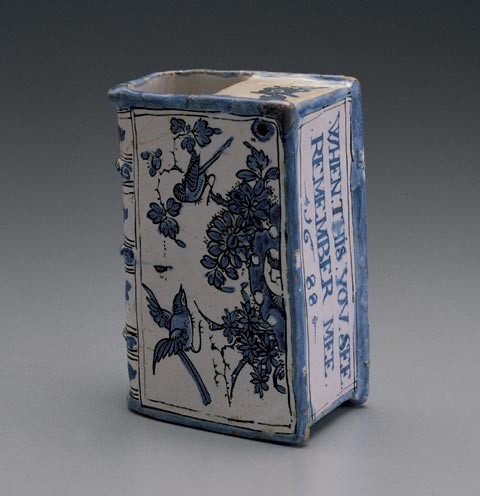
Hand warmer, probably London, dated 1688. Delftware (tin-glazed earthenware). H. 4 7/8". Molded in the style of a book, this object was thought to hold hot water. Inscribed “when this yov see / remember mee / 1688.”
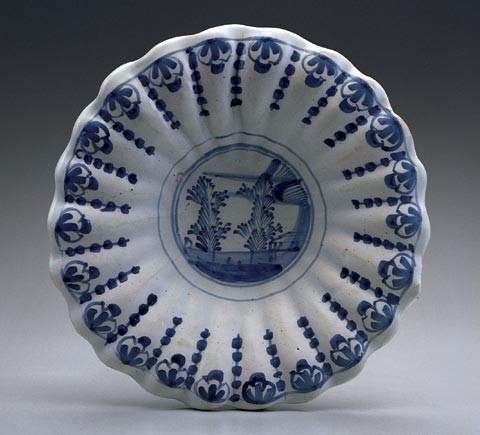
Dish, probably London, ca. 1690. Delftware. D. 8 3/4". This press-molded dish is of a type made in England and on the Continent. No foot ring is present, often an English feature.

Mug, attributed to David and John Philip Elers, probably Staffordshire, ca. 1695. Unglazed red stoneware. H. 3 5/8". The mug was slip cast and subsequently turned on a lathe. The branch and leaf sprigs were mold applied.
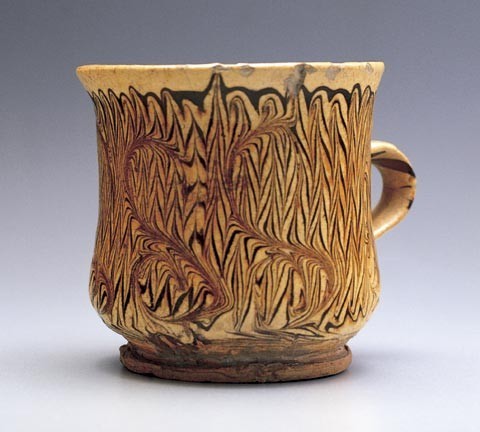
Cup, probably Staffordshire, 1690–1700. Slipware, combed or feathered. H. 4". The potter added the unusual “S” pattern in the decoration.
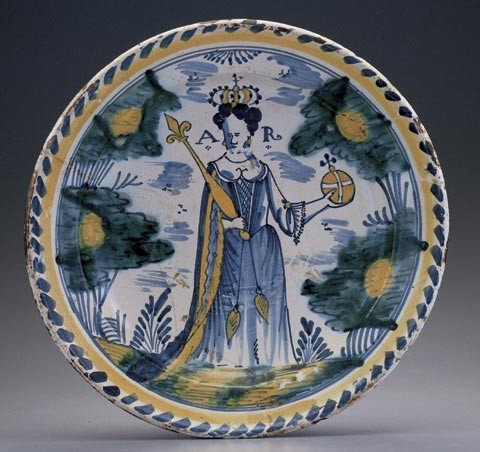
Dish or charger, probably London, 1702–1714. Delftware. D. 14". Inscribed “A R” for Anna Regina or Queen Anne. The back of this charger has a lead glaze over the tin glaze and a low pedestal foot.

Plate, London, 1740–1760. Delftware. D. 8 5/8". (Ex-collection: Dennis J. Cockell.)
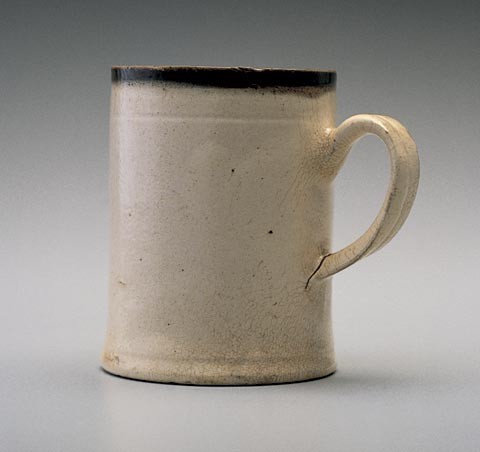
Mug, Staffordshire, 1720–1730. Salt-glazed stoneware. H. 3 1/8". Stoneware clay covered in a white slip and iron oxide applied to rim.
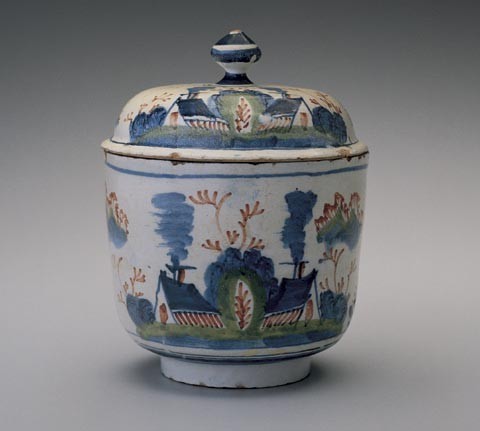
Sugar basin and cover, probably Bristol or Brislington, 1720–1730. Delftware. H. 6".

Figure of bird, Staffordshire, 1725–1730. Salt-glazed stoneware. H. 5 1/8". Slip and incised decoration. (Ex-collection: Major Cyril Earle.)

Cream jug, Staffordshire, ca. 1740.
Salt-glazed stoneware. H. 3 1/8". Mold-applied blue clay sprigs and tripod-footed base after a silver shape. (Ex-collections: Major Cyril Earle, Mrs. Catherine Collins.)
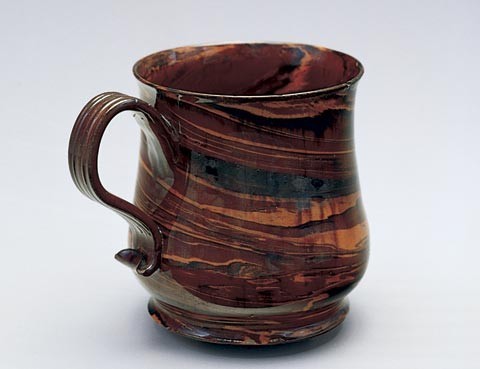
Mug, attributed to Samuel Bell, Staffordshire (Newcastle-under-Lyme), ca. 1740. Agateware. H. 4 1/2". Thrown on the wheel, this mug is composed of different-colored earthenware clays.
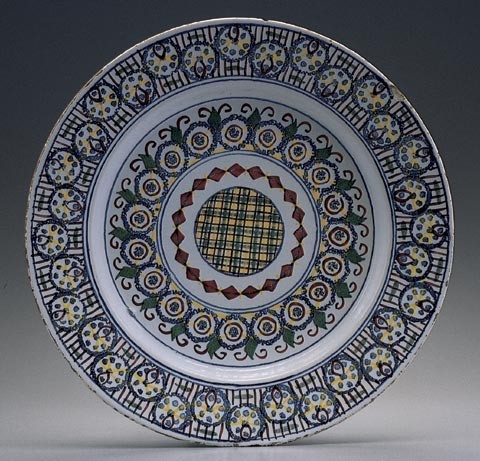
Dish, Bristol, ca. 1740. Delftware. D. 12 7/8". Decorated in a stamped circle technique. This large dish has a trimmed foot ring.
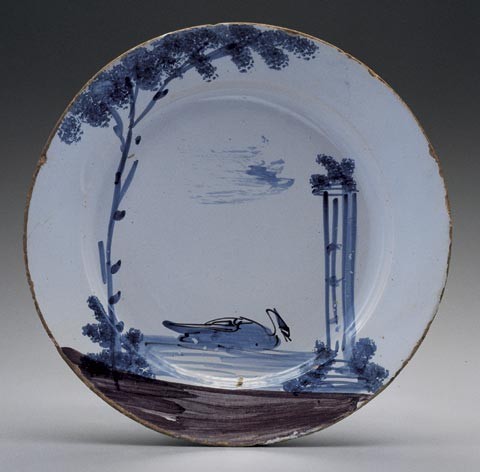
Plate, Bristol, 1740–1760. Delftware. D. 9".
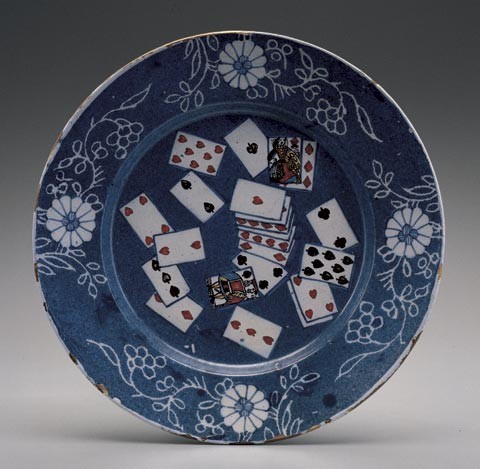
Plate, London, 1745–1750. Delftware. D. 9". The card motifs are painted in the reserve area of a dense cobalt “powder” ground.

Jug, Staffordshire, 1750–1765. Slipware. H. 5 1/2". The checkerboard slip decoration is highlighted with cobalt blue.
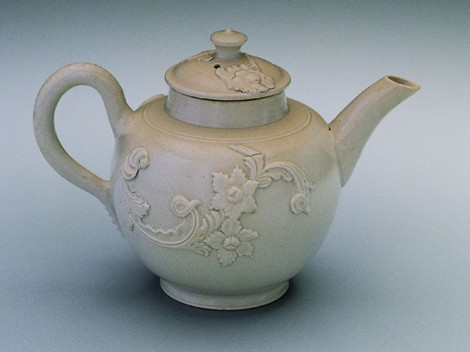
Teapot, Staffordshire, 1750–1760. Salt-glazed stoneware. H. 4 1/8". (Ex-collection: Mrs. Eugenia Cary Stoller.)
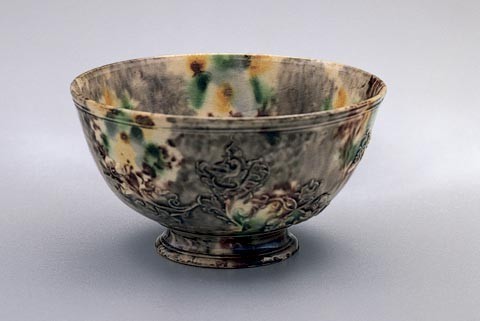
Bowl, Staffordshire, 1750–1760. Cream-colored earthenware. D. 4 1/2". Mold-applied sprig decoration and underglaze oxide colors. (Ex-collection: Sir Victor and Lady Gollancz.)
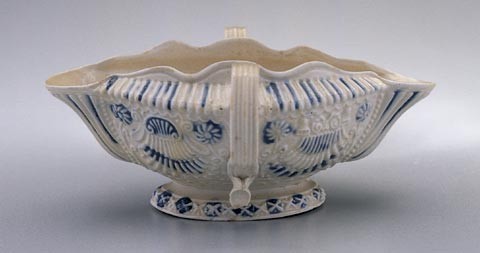
Sauceboat, Staffordshire, 1750–1760. Salt-glazed stoneware. L. 6 5/8". After a silver shape, this sauceboat was slip cast and highlighted with dabbed cobalt blue.

Teapot, Staffordshire, 1755–1760. Colored-body earthenware. H. 4 3/4"
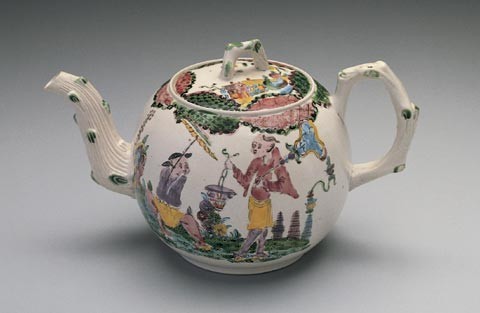
Teapot, Staffordshire, 1755–1765. Salt-glazed stoneware. H. 4 7/8". The polychrome decoration was enameled over the salt glaze and refired to set the colors.
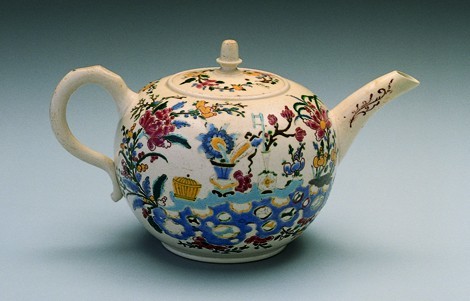
Teapot, Staffordshire, 1755–1765. Salt-glazed stoneware. H. 3 7/8". (Ex-collection: Mrs. Russell S. Carter.)

Chimney vase, probably Liverpool, ca. 1755. Delftware. H. 5 3/8". This type of decoration is generally referred to as the Fazackerly colors.
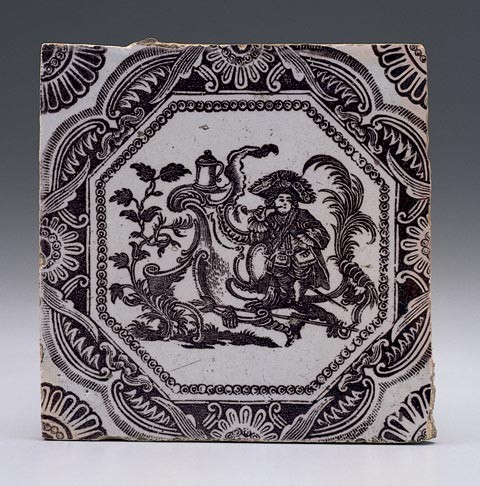
Wall tile, attributed to John Sadler printshop, Liverpool, 1756–1757. Delftware. W. 5". Woodblock print after Nilson of Augsburg.
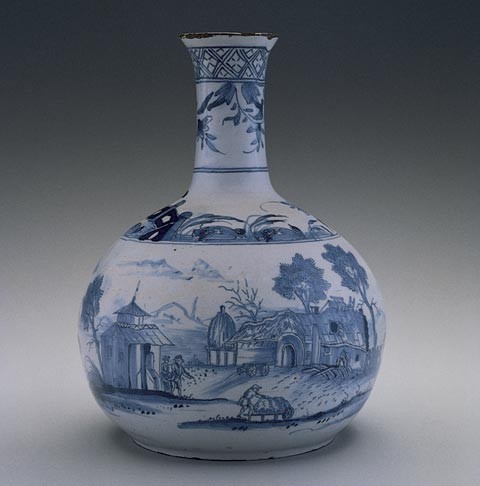
Water bottle, probably Liverpool, ca. 1760. Delftware. H. 8 1/4". The painted scenes include both Western and chinoiserie images.
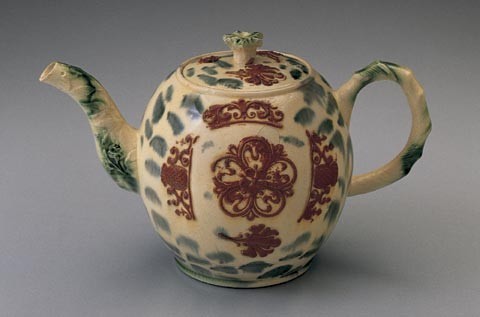
Teapot, probably Staffordshire, ca. 1760. Cream-colored earthenware. H. 4 3/4". A very unusual teapot with mold-applied brown clay and underglaze oxide colors.

Monkey figure, Staffordshire, ca. 1760. Cream-colored earthenware. H. 41/2". This press-molded figure is highlighted in underglaze oxide colors.

Plate, Staffordshire, ca. 1760. Cream-colored earthenware. D. 9 1/2". A very unusual press-molded plate with underglaze oxide colors.
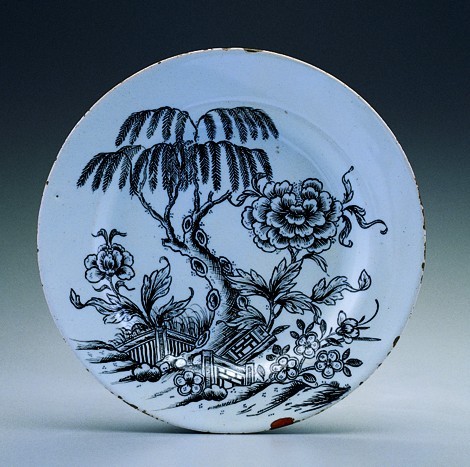
Plate, Liverpool, ca. 1760–1765. Delftware. D. 8 5/8". (Ex-collection: Frederic H. Garner, Moorwood Collection.)
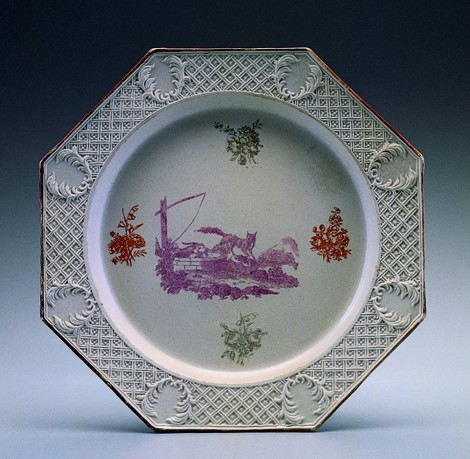
Plate, possibly Liverpool or Staffordshire, 1760–1765. Salt-glazed stoneware. D. 8 1/2". Three-color transfer print of Aesop’s The Fox and the Goat. (Ex-collection: Joseph E. Lowy.)

Teapot, Staffordshire, ca. 1765. Salt-glazed stoneware. H. 3 3/4". The colors on this pot appear to have been added over the saltglaze and refired with a lead glaze.
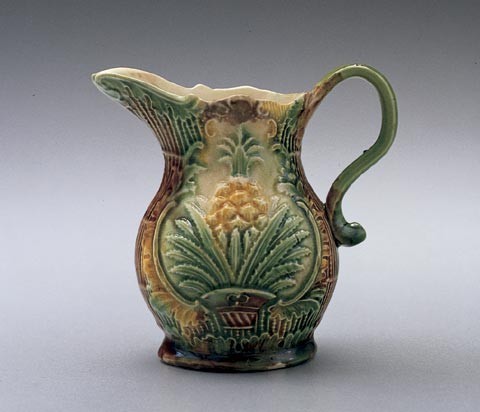
Milk jug, Staffordshire, ca. 1765. Cream-colored earthenware. H. 3 1/2". This press-molded pineapple jug is highlighted with underglaze oxide colors. Similar fragments have been excavated in Williamsburg, Virginia.
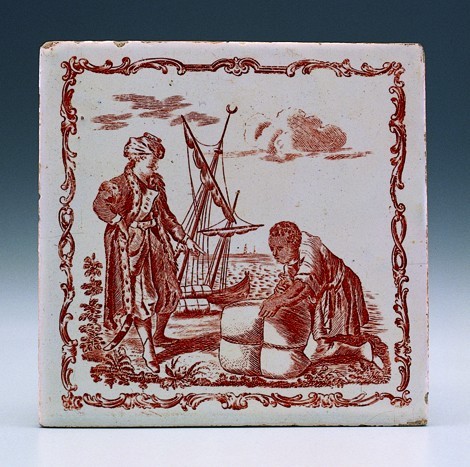
Wall tile, attributed to John Sadler and/or Guy Green printshop, Liverpool, 1764–1775. Delftware. W. 5 1/8". Transfer printed after an engraving depicting a Turkish merchant. (Ex-collection: Louis L. Lipski.)
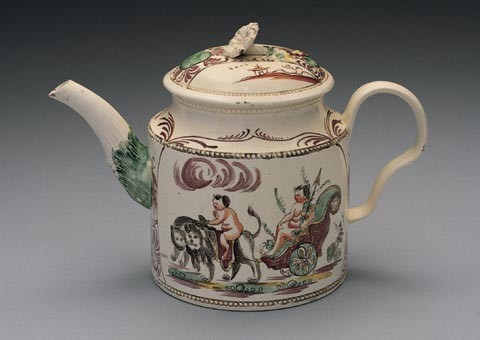
Teapot, attributed to William Greatbatch, Staffordshire (Fenton), 1770–1782. Creamware. H. 5 1/2". Gilding and enamel decoration of Cybele and Bacchus as satyrs.
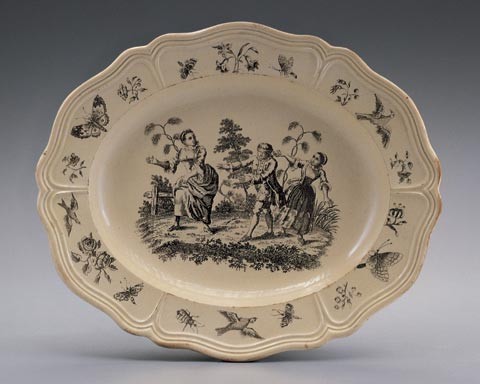
Dish, probably Staffordshire, 1770–1775. Creamware. L. 9 3/8 ". Transfer-print decoration of Blindman’s Buff. The rim border elements are very unusual as each is nonrepeating. Smooth bottom.
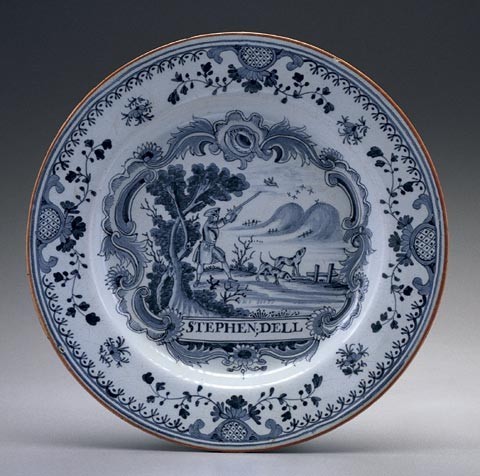
Plate, London, dated 1776. Delftware. D. 9". Inscribed “stephen dell” on front and “1776” on back.

Cup, possibly Yorkshire (Swinton), dated 1777. Slipware. H. 3". Slip-trailed decoration includes the initials “I– S.”
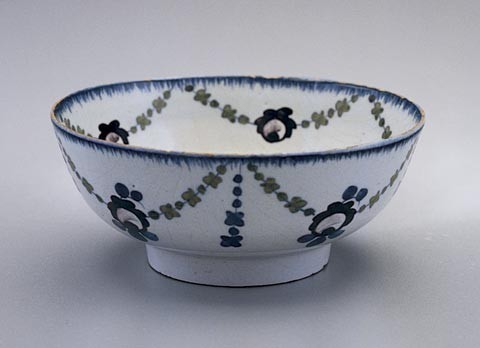
Bowl, London, 1780–1790. Delftware. D. 5 7/8". A late example of English delftware. Similar neoclassical decoration was also used on creamware and pearlware
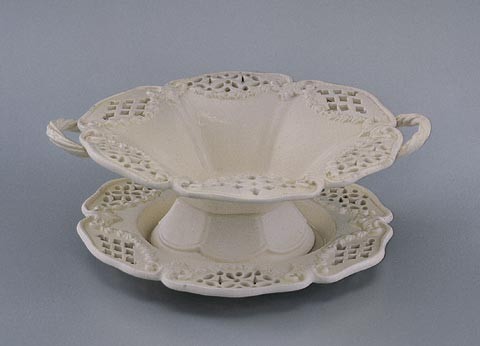
Basket and stand, probably Yorkshire, 1780–1790. Creamware. L. 6 3/8". Intended for confectionery or dessert. The detachable stand has a smooth bottom.

Troy D. Chappell.
